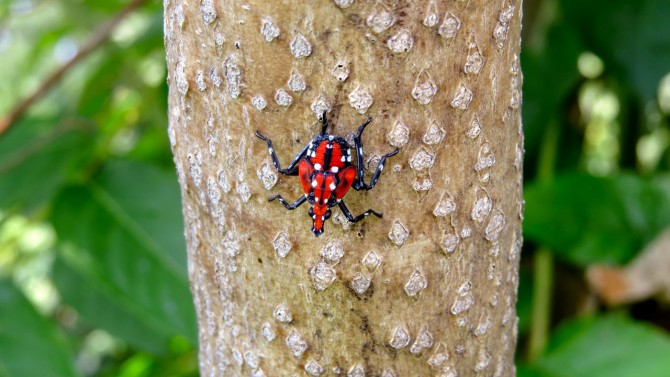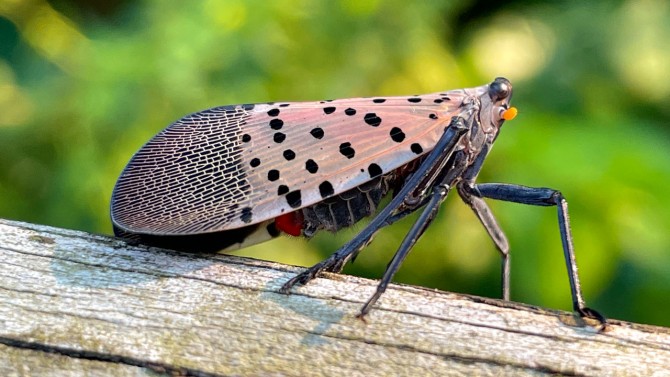
Alejandro Calixto, left, director of the CALS-based New York State Integrated Pest Management program, is pictured during a training with agricultural workers in Highland, Ulster County.
Spotted lanternfly spreading in New York state
By Krishna Ramanujan
The spotted lanternfly – an invasive, destructive pest with a wide range of hosts including grapes, apples, hops, maple and walnut – has spread to a growing number of counties in New York state.
The first major infestation in the state was detected in Staten Island in August 2020, and the insect appears to have established itself there. Two months ago, a population of spotted lanternflies was found in Orangeburg, Rockland County, but its establishment there remains too early to determine.
The pest has also been reported and confirmed in Sloatsburg, Rockland County; Port Jervis, Orange County; and in Ithaca.
While the tree of heaven is the pest’s preferred host, the insect is of agricultural concern as its host range covers some 70 different species of plants, including those that fuel the state’s agricultural economy. New York is the country’s second-largest apple producer with average annual harvests of close to 30 million bushels. The state’s wine industry – from grape growing to bottle sales – generates an annual economic impact of $6.65 billion, according to the New York Wine and Grape Foundation.
“Once these insects reach some of the [state’s] grape production areas, there’s going to be an impact,” said Alejandro Calixto, director of the New York State Integrated Pest Management program at the College of Agriculture and Life Sciences.
If members of the public find a spotted lanternfly, they should contact the New York State Department of Agriculture and Markets (Ag and Markets), Cornell University, or their county or town to report it, Calixto said. “Early detection is very important,” he said.
To help with outreach and education in the state’s agricultural communities, Cornell has been running trainings. This week, Calixto and others conducted sessions with Hispanic agricultural workers in Highland, Ulster County.
“They’re the ones on the front lines, so we’re teaching them how to identify and spot those insects and then to report them to their managers so they can take action quickly,” Calixto said.
In areas where the pest has been found, Ag and Markets staff slows its spread by using different tactics including removal of infested plants, especially tree of heaven, a preferred host plant for this insect.
Native to Asia, the spotted lanternfly was first discovered in the U.S. in southeastern Pennsylvania in 2014. It has since spread to New Jersey, Delaware, Maryland, Virginia and New York.
Spotted lanternflies are not flies, but are actually large planthoppers, with adults growing to about an inch long with gray wings and black spots. They undergo five life stages before reaching adulthood, including a fourth stage when they are vibrant red, with patches of black with white spots. They don’t bite or sting, and pose no threat to people or animals.
The nymphs and adults have mouthparts that drill into plants and suck sap, causing damage that makes plants susceptible to other bugs and disease. They also excrete a sticky fluid called honeydew, which attracts other insects, sticks on cars and can become a breeding ground for sooty mold.
Media Contact
Get Cornell news delivered right to your inbox.
Subscribe



